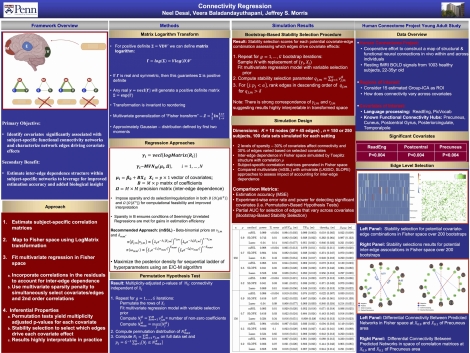Neel Desai
Connectivity Regression

Presenter

Neel Desai is a postdoctoral research fellow in Biostatistics working with Dr. Jeffrey S. Morris and Dr. Taki Shinohara
Abstract
One key scientific problem in neuroscience involves assessing how functional connectivity networks in the brain vary across individuals and subject-specific covariates. In this article we introduce a general regression framework for regressing subject-specific connectivity networks on covariates while accounting for inter-edge dependence within the network. Our approach utilizes a matrix-logarithm function to transform the network object into an alternative space in which Gaussian assumptions are justified and positive semidefinite constraints are automatically satisfied. Multivariate regression models are fit in this transformed space, with the covariance accounting for inter-edge network dependence and multivariate penalization used to induce sparsity in regression coefficients and covariance elements. We use permutation tests to perform multiplicity-adjusted inference to identify which covariates affect connectivity, and stability selection scores to indicate which network circuits vary by covariate. Simulation studies validate the inferential properties of our proposed method and demonstrate how estimating and accounting for inter-edge dependence when present leads to more efficient estimation, more powerful inference, and more accurate selection of which network circuits vary by covariates. We apply our method to data from the Human Connectome Project (HCP) Young Adult study, revealing insights into how connectivity varies across language processing covariates and structural brain features.
Keywords
Functional Connectivity, Sparse Multivariate Regression, Graphical Models, Network RegressionAbout Us
To understand health and disease today, we need new thinking and novel science —the kind we create when multiple disciplines work together from the ground up. That is why this department has put forward a bold vision in population-health science: a single academic home for biostatistics, epidemiology and informatics.
© 2023 Trustees of the University of Pennsylvania. All rights reserved.. | Disclaimer

